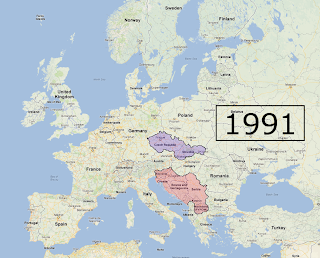Flags
There are many
symbols representing Slovenia and Slovenians:
- The Prince's Stone represents the first
Slovenian country and reminds also that Slovenians already had independency in the
earlier history.
- 'Abecednik and Katekizem' and Primož
Trubar represent the transformation of the spoken language into written
language. An achievement that ensured that the language will never be forgotten
and could be read by the next generations.
- France
Prešeren showed that Slovenian language can be also used for poetry
- A Powerful
symbol is also the mountain peak Triglav which is the highest one in the
country. It is also present in the modern coat of arms.
- But I think that
the most powerful symbol for all Slovenians has always been the struggle.
Whether it was the revolt against the Franks in 10th century, or against the Turks;
or it was the peasant revolt in the 17th century, the political rallies and
movements in the 19th century, or the fight against Fascism and germanization,
or the war for independency against Yugoslavia in the 20th century, struggle
has always been present in Slovenian history.
One of the most important symbols, however,
is of course the flag. The Slovenian flag consists of three colours white, blue
and red (WBR) with the Coat of Arms at the upper left side.
 |
| Slovenian flag |
But if you look
at the flags of the other Slavic countries you can see that there are quite
some similarities among them. Many of them use the WBR colours. Actually, even
some of the big countries worldwide use the combination of these three colours like
France, UK, USA, North Korea, Chile, Netherlands, Norway.... So why are these colours
so special and are all these flags somehow related to each other?
 |
| European countries with WBR colours |
Slavic Countries
As we can see in
the picture below there are some flag similarities among the Slavic countries.
Six out of thirteen have the combination of white, blue and red. Let's take a
look into each flag's background.
 |
| Slavic countries and their flags |
Slovenia
 The Slovenian flag with white, blue and red
stripes was firstly introduced in March 1848, during the so called Spring of Nations.
These three colours were introduced in the rally of Slovenian students in
Vienna, the capital of the Austrian Empire at the time, and shortly after that on
7. April in Ljubljana. The colours were taken from the Carniola Coat of Arms,
made in 1463, which was at that time the center of the Slovenian space. Before
that in the year 1836 the Austrian Emperor Ferdinand I. recognized these
colours as the colours of Carniola.
The Slovenian flag with white, blue and red
stripes was firstly introduced in March 1848, during the so called Spring of Nations.
These three colours were introduced in the rally of Slovenian students in
Vienna, the capital of the Austrian Empire at the time, and shortly after that on
7. April in Ljubljana. The colours were taken from the Carniola Coat of Arms,
made in 1463, which was at that time the center of the Slovenian space. Before
that in the year 1836 the Austrian Emperor Ferdinand I. recognized these
colours as the colours of Carniola. Others claim, that the colours came from a Pan-Slavic
movement, which had a Slavic congress in Prague in June 1848. At that congress
members of all Slavic countries met and discussed on the identity of the Slavs
under the germanisation. At that congress even a Pan-Slavic flag was
introduced, which also had WBR.
Others claim, that the colours came from a Pan-Slavic
movement, which had a Slavic congress in Prague in June 1848. At that congress
members of all Slavic countries met and discussed on the identity of the Slavs
under the germanisation. At that congress even a Pan-Slavic flag was
introduced, which also had WBR.
The congress was, however, held after the first
Slovenian flags were already shown. Maybe this congress just helped to make
these colours more popular among people.
Croatia

The colours represent the three parts of Croatia: the Kingdom of Croatia (white, red), the Kingdom of Slavonia (blue, white), and the Kingdom of Dalmatia (blue and yellow). These colours have been used ever since 1848.
Serbia
 Red and blue colours were used in the 13th
century under the king Vladislav I of Serbia. White stripe was added in the
year 1835 and the flag has been used in that form ever since.
Red and blue colours were used in the 13th
century under the king Vladislav I of Serbia. White stripe was added in the
year 1835 and the flag has been used in that form ever since.




